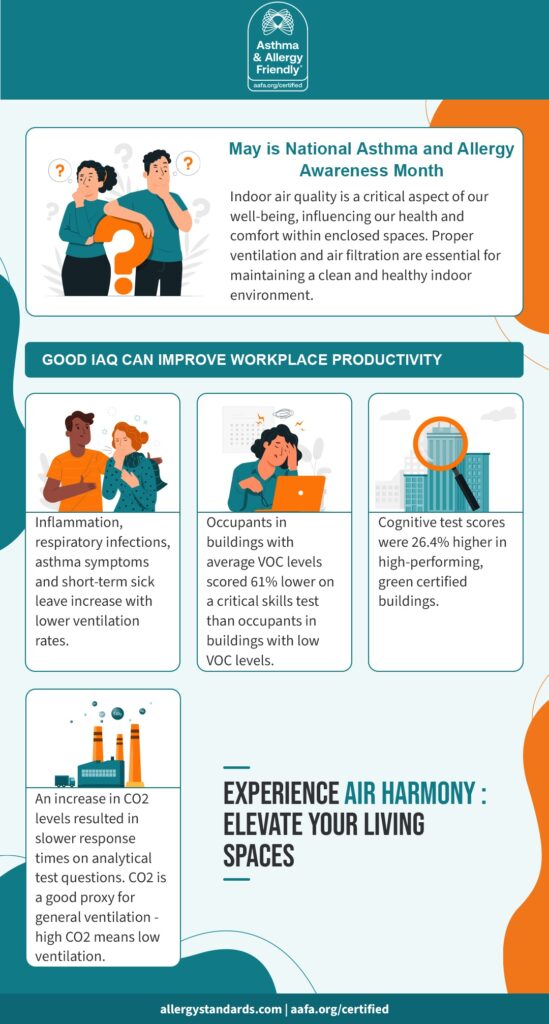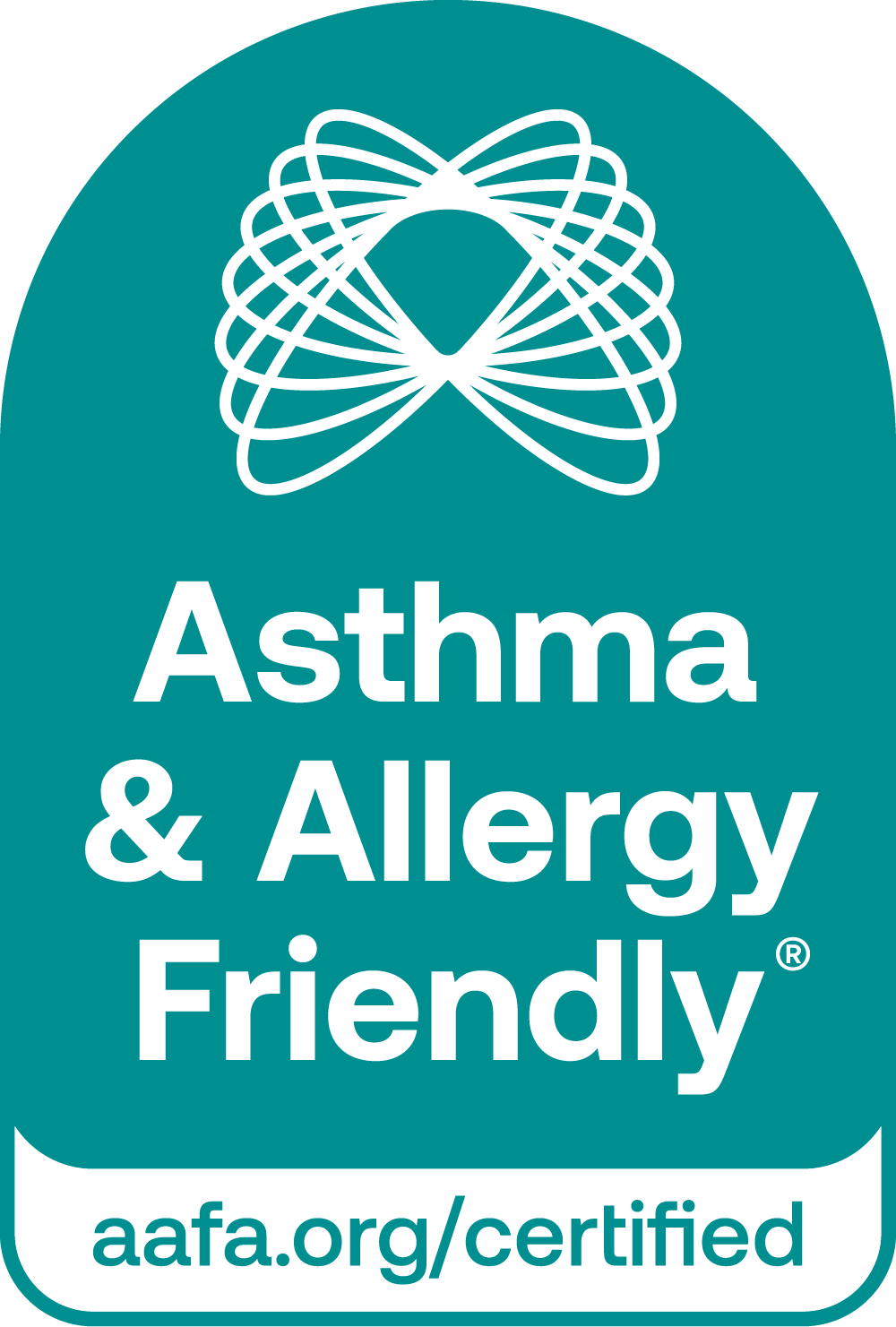Certified products can support indoor air quality in the workplace, enhancing employee well-being, reducing absenteeism, and boosting productivity

When we think about staying healthy at work, we often focus on ergonomics, balanced meals, or regular breaks. But there’s another factor we sometimes overlook: the quality of the air we breathe. With so much of our day spent in offices or indoor workplaces, the air circulating through those spaces plays a central role in both our physical health and cognitive performance.
This May, as we mark Asthma and Allergy Awareness Month, it’s a timely reminder that indoor air quality (IAQ) has a significant impact on individuals with asthma and allergies, and on the overall health of the workforce. In this article, we explore the relationship between IAQ and workplace wellness, the factors that affect it, and how Certified Asthma & Allergy Friendly® products can help improve it.
Why Indoor Air Quality in the Workplace Impacts Our Health
Indoor Air Quality (IAQ) refers to the quality of air within and around buildings, especially in relation to occupant health and comfort. While outdoor pollution often garners more attention, indoor air can be two to five times more polluted than outside air. Considering that we spend up to 90% of our time indoors, much of it at work, IAQ has a profound effect on well-being.
Poor IAQ has been linked to a variety of health issues, from mild symptoms like fatigue and headaches to more severe outcomes such as respiratory infections, allergy flare-ups, and asthma attacks. For people with asthma and allergies, the stakes are even higher. In fact:
- There are 102.1 million people in the U.S. with allergies, including 82.1 million adults and 20 million children. Many of them spend their days in schools, offices, and workplaces where poor air quality can worsen symptoms.
-
There are over 28 million (7.7%) people in the U.S. with asthma, including over 23 million (8.9%) adults and 4.9 million (6.7%) children.
- 50% of illnesses are caused or aggravated by poor indoor air.
- the economic burden of indoor air pollution is undeniably significant, with estimates ranging from over $100 billion to $150 billion annually.
“Sick Building Syndrome” (SBS), a term coined in the 1970s, described the health problems caused by inadequate ventilation and pollutant buildup in tightly sealed office buildings. Though the term is less commonly used today, the underlying issues remain, manifesting in symptoms such as eye irritation, dizziness, and respiratory distress, which often resolve once a person leaves the affected building.
The consequences of poor IAQ go beyond physical health. Buildings with high VOCs (volatile organic compounds) have been associated with lower performance on cognitive tests, up to 61% lower compared to low-VOC environments. In contrast, workers in green-certified buildings, which typically feature superior ventilation and material choices, showed a 26.4% improvement in cognitive test performance.
Evidence-Based Design and Indoor Air Quality
Evidence-based design, originating in healthcare, is increasingly applied to commercial and office spaces. It emphasizes decision-making based on scientific evidence to create environments that support human health and performance.
In the context of IAQ, evidence-based design supports the use of low-emitting materials, optimized ventilation strategies, and independently certified products to reduce pollutants and enhance occupant well-being. By integrating research-backed solutions, employers and designers can make smarter decisions about the materials and systems that define workplace environments.
Key Workplace Factors That Impact IAQ
Several elements can influence the indoor air quality in the workplace:
Poor Ventilation
Insufficient ventilation allows pollutants like CO₂, VOCs, and particulate matter to accumulate. This can degrade air quality and impair cognitive function. On the flip side, proper ventilation systems can reduce energy costs by up to 30%, demonstrating a dual benefit for health and efficiency.
HVAC Systems and Filters
HVAC systems that are poorly maintained or equipped with inadequate filters can recirculate dust, allergens, and mold spores. Air filters that do not meet standards, or are not regularly changed, fail to effectively capture airborne contaminants.
VOCs from Materials
Paints, adhesives, flooring, insulation, and cleaning products can emit VOCs, impacting respiratory health and cognitive performance. Consistent exposure to elevated VOC levels can lead to both acute and chronic health concerns.
Flooring and Insulation
These materials can trap dust, moisture, and allergens, and some may release VOCs over time. Inadequate cleaning or moisture buildup can also lead to mold growth, a serious concern for respiratory health.
Cleaning Products
Conventional cleaners often contain harsh chemicals that aggravate asthma and allergies. Switching to low-emission, scientifically tested alternatives is a critical step toward healthier indoor air.

Good indoor air quality improves cognitive performance and reduces sick leave, key takeaways for Asthma and Allergy Awareness Month
How the Asthma & Allergy Friendly® Certification Program Helps
The Asthma & Allergy Friendly® Certification Program, developed by Allergy Standards Ltd in partnership with the Asthma and Allergy Foundation of America (AAFA), identifies products that support healthier indoor air by undergoing rigorous scientific testing.
Products are tested to ensure they:
- Emit low levels of VOCs and other pollutants
- Reduce or trap allergens effectively
- Maintain performance over time and under real-life conditions
This holistic approach evaluates not only emissions but also allergen control, cleanability, and product longevity, all critical factors for maintaining healthier indoor environments.
Our Certified Partners: Creating Healthier Workplaces Together
We work with industry-leading brands across key product categories to help workplaces improve air quality and employee well-being:
HVAC Filters
Air Purifiers
Cleaning Products
Insulation
Flooring
Paint
Each of these partners has earned certification by demonstrating that their products meet the high standards set by the Asthma & Allergy Friendly® Certification Program. By choosing these products, facility managers, designers and business leaders are making measurable investments in employee wellness and environmental responsibility.
Why Certified Products Make a Difference
Healthier Environments
Certified products reduce exposure to allergens and irritants, making workplaces more inclusive for employees with asthma, allergies, or chemical sensitivities.
Increased Productivity
Cleaner air has been linked to improved decision-making, reduced absenteeism, and higher cognitive function, benefits that translate into real-world performance.
ESG and Sustainability Alignment
Certified products contribute to LEED credits and WELL Building Standard compliance. This helps companies demonstrate commitment to health, sustainability, and measurable ESG outcomes.
Conclusion
Indoor air quality isn’t just a comfort factor, it’s a strategic priority for any business that values employee health and performance. As we observe Asthma and Allergy Awareness Month, it’s the perfect time to re-evaluate your workplace environment.
Choosing Asthma & Allergy Friendly® Certified products means making science-backed decisions that improve IAQ, reduce risk, and support your workforce. It’s a commitment to healthier buildings, and healthier people.
